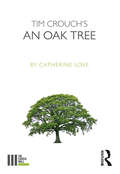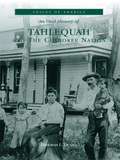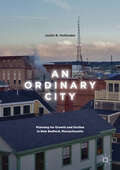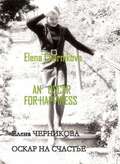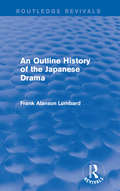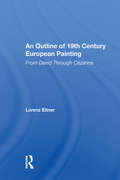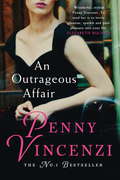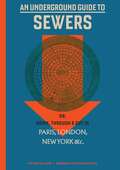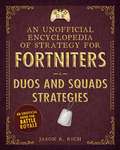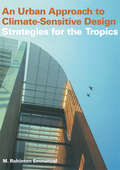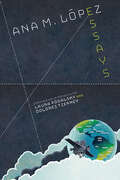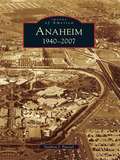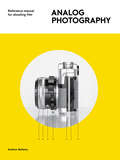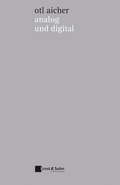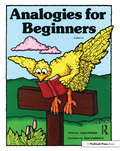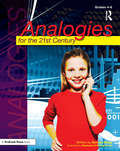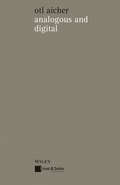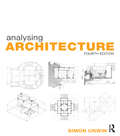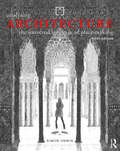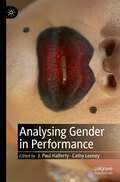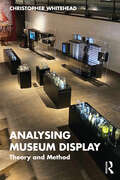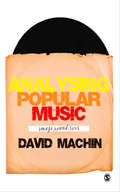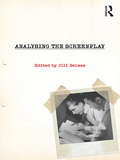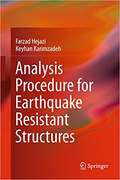- Table View
- List View
An Oak Tree
by Catherine LoveFirst Published in 2017. Routledge is an imprint of Taylor & Francis, an Informa company.
An Oral History of Tahlequah and The Cherokee Nation
by Deborah L. DuvallThese pages are filled with memories and favorite tales that capture the essence of life in the Cherokee Nation. Ms. Duvall invites the reader to follow the tribe from its pre-historic days in the southeast, to early 20th century life in the Cookson Hills of Oklahoma. Learn about Pretty Woman, who had the power over life and death, or the mystical healing springs of Tahlequah. Spend some time with U.S. Deputy Marshals as they roam the old Cherokee Nation in pursuit of Indian Territory outlaws like Zeke Proctor and Charlie Wickliffe, or wander the famous haunted places where ghost horses still travel an ancient trail and the spirits of long-dead Spaniards still search for gold.
An Ordinary City: Planning for Growth and Decline in New Bedford, Massachusetts
by Justin B. HollanderThis book paints an intimate portrait of an overlooked kind of city that neither grows nor declines drastically. In fact, New Bedford, Massachusetts represents an entire category of cities that escape mainstream urban studies' more customary attention to global cities (New York), booming cities (Atlanta), and shrinking cities (Flint). New Bedford-style ordinary cities are none of these, they neither grow nor decline drastically, but in their inconspicuousness, they account for a vast majority of all cities. Given the complexities of growth and decline, both temporarily and spatially, how does a city manage change and physically adapt to growth and decline? This book offers an answer through a detailed analysis of the politics, environment, planning strategies, and history of New Bedford.
An Oscar for Happiness: An Oscar for Happiness
by Nina Šoltić Elena ChernikovaThis is an autobiographical story. It covers the first years of the author's writing and creation.
An Ottawa Album: Glimpses of the Way We Were
by Marion Van de WeteringThis illustrated history of Ottawa traces the city’s development from the days when Bytown was a lumber village to its emergence as Canada’s capital and fourth-largest urban area. From the earliest photographs of the original Centre Block of the Parliament Buildings, through the VE-Day and VJ-Day celebrations at the end of World War II and beyond, this beautiful book of superb black-and-white photographs and informative text offers a charming glimpse of the evolving city. The photographs have been chosen both for their historical importance and their quality as visual art. They show a cross-section of life in the developing capital from the formality of Rideau Hall to working people selling wood and straw in Byward Market. This art, among the best from Canada’s early photographers, has been culled from major collections in the National Archives of Canada and Ottawa’s city archives. Many of the photographs have never been published before.
An Outline History of the Japanese Drama (Routledge Revivals)
by Frank Alanson LombardStudents of international drama are turning more and more to the study of Japanese drama, desirous to know to what extent its development duplicates or differs from the evolution of drama in other countries. Stimulated by the colour, originality, power, and poetry, they are interested to know more. This title, first published in 1928, traces the general development of the drama of the Japanese. This book will be of interest to students of drama, theatre studies and Asian Studies.
An Outline Of 19th Century European Painting: From David Through Cezanne
by Lorenz EitnerThis one-volume edition contains both text and plates and includes corrections in the text and bibliography made since the books publication in 1987. There are concise monographic chapters on the important artists and movements of the period, with material on each artists life and work, characteristics of style, and the relationship of the artistic movements to historical and intellectual currents of the time. The author covers a wide range of material and his presentation is lucid and perceptive. Neoclassicism, Romanticism, Realism, Academics and Salon Painters, and Impressionism are covered, and the following artists are included: David, Gros, Girodet, Grard, Gurin, Prudhon, Goya, Fuseli, Blake, Runge, Friedrich, Turner, Constable, Igres, Gricault, Delacroix, Corot, Rousseau, Daumier, Millet, Courbet, Manet, Degas, Monet, Renoir, Sisley, Pissarro, and Czanne.
An Outrageous Affair
by Penny Vincenzi'I defy any reader, once they've taken the smallest nibble, not to gobble it all down' Sunday ExpressIn wartime Suffolk, Caroline Hunterton fell in love. Now, decades on, that love becomes the only connection between a tragic Hollywood accident in the 1950s, and a terrible suicide twenty years later. Caroline has spent years trying to keep those secrets from her two daughters, Chloe and Fleur, who have been separated by the Atlantic and have grown up hating one another. But soon, their shared past may be all that can save the family... From rural England and Hollywood's glory days, to London's theatreland and New York's adland, An Outrageous Affair explores the many forms love takes, and how it can change us all.
An Underground Guide to Sewers: or: Down, Through and Out in Paris, London, New York, &c.
by Stephen HallidayA global guide to sewers that celebrates the magnificently designed and engineered structures beneath the world's great cities. The sewer, in all its murkiness, filthiness, and subterranean seclusion, has been an evocative (and redolent) literary device, appearing in works by writers ranging from Charles Dickens to Graham Greene. This entertaining and erudite book provides the story behind, or beneath, these stories, offering a global guide to sewers that celebrates the magnificently designed and engineered structures that lie underneath the world's great cities. Historian Stephen Halliday leads readers on an expedition through the execrable evolution of waste management—the open sewers, the cesspools, the nightsoil men, the scourge of waterborne diseases, the networks of underground piping, the activated sludge, the fetid fatbergs, and the sublime super sewers. Halliday begins with sanitation in the ancient cities of Mesopotamia, Greece, and Imperial Rome, and continues with medieval waterways (also known as “sewage in the street”); the civil engineers and urban planners of the industrial age, as seen in Liverpool, Boston, Paris, London, and Hamburg; and, finally, the biochemical transformations of the modern city. The narrative is illustrated generously with photographs, both old and new, and by archival plans, blueprints, and color maps tracing the development of complex sewage systems in twenty cities. The photographs document construction feats, various heroics and disasters, and ingenious innovations; new photography from an urban exploration collective offers edgy takes on subterranean networks in cities including Montreal, Paris, London, Berlin, and Prague.
An Unofficial Encyclopedia of Strategy for Fortniters: Duos and Squads Strategies (Encyclopedia for Fortniters)
by Jason R. RichIn addition to the Solo game play mode (which pits each gamer up against up to 99 others in a real-time battle), the Duos mode allows gamers to team up with one friend in a quest to defeat all other gamers during a match. Meanwhile, the Squads mode allows teams of four players to enter into a match and work together as they battle against up to 96 other gamers. The Duos and Squads game play modes are permanent features built into the game, and they’ve proven to be extremely popular, since Fortnite: Battle Royale is, for the most part, cross-platform compatible. Thus, someone experiencing the game on a PS4 can team up with a PC user, for example, to play against a random section of other gamers, in real-time. An Encyclopedia of Strategies for Fortniters: Duos and Squads Strategies will be the first book in this unofficial strategy guide series to offer in-depth coverage of Fortnite: Battle Royale’s team-oriented game play modes. Thus, this unofficial strategy guide will be chock full of proven strategies and game play tips designed to help teams achieve victory in the Fortnite: Battle Royale matches they participate in. This expanded (approximately 176-page) guide will include a comprehensive overview of the Fortnite: Battle Royale game, with a special focus on the game’s team-oriented game play modes. The full-color book will appeal to readers age 8 and up, regardless of which gaming platform they’re using. Throughout each match, gamers must: Focus on survival Avoid the deadly storm Explore the island Gather resources Build structures and fortresses Find, collect, and utilize weapons and ammunition Acquire and use loot items Engage in combat against enemy soldiers with the goal of becoming the last person alive at the end of the match When experiencing any of the team-oriented game play modes, cooperative gameplay (teamwork) and communication with team members become vital. An Encyclopedia of Duos and Squads Strategies will soon be an indispensable resource for gamers experiencing the Duos or Squads game play modes (or any of the other team-oriented game play modes added to Fortnite: Battle Royale on a temporary basis).
An Urban Approach To Climate Sensitive Design: Strategies for the Tropics
by Rohinton EmmanuelThe need to respond to the rapidly changing city climate is particularly urgent in the tropics where the urban transition is currently at its peak. While the need is clearly felt by the tropical urban dwellers, texts that provide an overview of the problem and indicate possible design solutions are rare. This comprehensive reference will be welcomed by student and practising architects as well as other built envronment professionals engaged with the environmental effects of building in worldwide warm and humid climates.
Ana M. López: Essays (SUNY series in Latin American Cinema)
by Ana M LópezAna M. López is one of the foremost film and media scholars in the world. Her work has addressed Latin American filmmaking in every historical period, across countries and genres—from early cinema to the present; from Brazil, Cuba, and Mexico to diasporic and Latinx cinemas in the United States; from documentary to melodrama to politically militant film. López's groundbreaking essays have transformed Latin American film studies, opening up new approaches, theoretical frameworks, and lines of investigation while also extending beyond cinema to analyze its connections with television, radio, and broader cultural phenomena. Bringing together twenty-five essays from throughout her career, including three that have been translated into English for this volume, Ana M. López is divided into three sections: the transnational turn in Latin American film studies; analysis of genre and modes; and debates surrounding race, ethnicity, and gender. Expertly curated and edited by Laura Podalsky and Dolores Tierney, the volume includes introductory material throughout to map and situate López's key interventions and to aid students and scholars less familiar with her work.
Anaheim: 1940-2007
by Stephen J. FaesselAfter the developments that the World War II era brought to the small agricultural community of Anaheim, the major transformation arrived in 1955. Anaheim changed forever from a sleepy and proud little town into the center for entertainment and tourism in Southern California with the arrival of Disneyland. Other national and regional businesses and franchises arrived in and around this Orange County anchor city--including the California Angels baseball club, the Anaheim Convention Center, and such aerospace giants as Boeing and Rockwell International--and Anaheim grew exponentially. This collection of more than 200 vintage and contemporary images depict the results of Anaheim's far-sighted elected and business leaders, who nurtured the city from its agrarian roots and made it into one of the nation's fastest growing cities in the 1960s.
Analog Photography: Reference Manual for Shooting Film
by Andrew BellamyAttracted by the image quality, the tactile joy of a finely made camera, and the affordable prices of vintage equipment, photographers around the world are rediscovering the joys of manual photography. This comprehensive guide to shooting film photography covers all the bases, from setting up a camera through film processing. In a convenient format, filled with diagrams, examples, and illustrations, Analog Photography is a portable reference tool for neophytes and experienced photographers alike. With an irresistible package inspired by the aesthetics of vintage user manuals, this is "a great-looking publication and a fantastic place from which to start, or rekindle, a journey into film photography" (Creative Review).
Analog und Digital: schriften zur philosophie des machens
by Otl AicherOtl Aicher (1922 –1991) war einer der herausragenden Vertreter des modernen Designs, er war Mitbegründer der legendären Hochschule für Gestaltung Ulm (HfG). Der heute geläu_ ge Begriff der visuellen Kommunikation ist auf ihn zurückzuführen. Was er seit den 1950er Jahren geschaffen hat, erinnert sei z. B. an die Piktogramme für die Olympischen Sommerspiele München 1972, gehört zu den ganz großen Leistungen der visuellen Kultur unserer Zeit.Ein wesentlicher Aspekt der Arbeiten von Aicher ist deren Verankerung in einer von Denkern wie Ockham, Kant oder Wittgenstein inspirierten „Philosophie des Machens“, die die Voraussetzungen und Ziele sowie die Gegenstände und Ansprüche von Gestaltung zum Thema hat. Aichers Schriften zu Fragen des Designs von der visuellen Gestaltung bis hin zur Architektur liegen in diesem Band in geschlossener Form vor.Wenn Aicher das Analoge und Konkrete dem Digitalen und Abstrakten vorzieht, tut er dies mit philosophischer Absicht. Er relativiert die Rolle der reinen Vernunft. Er kritisiert den Rationalismus der Moderne als Ergebnis der Vorherrschaft des bloß abstrakten Denkens. Wer das Abstrakte dem Konkreten vorzieht, missversteht nicht nur die wechselseitige Abhängigkeit von Begriff und Anschauung. Er schafft nach Aichers Urteil auch eine falsche Hierarchie, eine Rangordnung, die kulturell verhängnisvoll ist. Das digitale, Abstrakte ist nicht höher, größer und wichtiger als das Analoge, Konkrete.Wilhelm Vossenkuhl
Analogies for Beginners: Grades 1-3
by Lynne ChathamAn analogy is a comparison that points out the similarities between things that are different in all other respects. Teaching students how to solve analogies not only develops their logical thinking, but also builds visual awareness and verbal proficiency.The seven different types of visual analogies and 14 different verbal analogies in Analogies for Beginners are perfect for beginning lessons in logical reasoning, flexible thinking, and vocabulary. Each page gives students an example of the type of analogy that is being introduced and then provides 7 (visual) or 10 (verbal) problems for them to solve. This combination of verbal and visual formats is an ideal way to introduce logical thinking in primary grades. Whether you have time for one analogy a day or a worksheet a week, students will benefit in many ways when analogies are part of your curriculum. The use of visual analogies is beneficial for developing visual analysis even for older students, but especially useful for nonreaders and students with developing English skills. The verbal analogies provide students with exercises that require them to use word comprehension and also to examine various characteristics, uses, and relationships.This is one of a series of analogy books. For younger students, use First Time Analogies. For older students, use Thinking Through Analogies, Analogies for the 21st Century, or Advancing Though Analogies. Grades 1-3
Analogies for the 21st Century: Grades 4-6
by Bonnie L. RisbyThis is it! Here's the perfect venue for intermediate teachers to combine thinking skills and vocabulary development. Step into the 21st century with lessons that not only present students with analogies, but also provide them with instructions on how to best solve these verbal puzzles.An analogy is a comparison between two things. It points out the similarities or likenesses between things that might be different in all other respects. These exercises not only build thinking skills and make students more flexible and analytical; they also enhance vocabulary and writing skills.Intermediate students will get a jump on thinking skills and test taking strategies with these sure-to-please exercises. Whether this book is their first encounter with analogies or whether they are veterans with a great deal of experience, Analogies for the 21st Century gives them the tools they need in a fun-to-use format. It provides thinking strategies to help recognize the unique relationships between paired items and how these relationships can be replicated. Each lesson introduces new types of analogies, gives examples, and offers hints on solving the analogies. Vocabulary reflects today's culture, and helpful hints help students to build skills that will allow them to perform better on tests.This is one of a series of analogy books. For younger students, use First Time Analogies or Analogies for Beginners. For older students, use Thinking Through Analogies or Advancing Though Analogies. Grades 4-6
Analogous and Digital
by Otl AicherOtl Aicher (1922-1991) was an outstanding personality in modern design, he was a co-founder of the legendary Hochschule fur Gestaltung (HfG), the Ulm School of Design, Germany. His works since the fifties of the last century in the field of corporate design and his pictograms for the 1972 Summer Olympics in Munich are major achievements in the visual communication of our times. "An integral component of Aicher's work is that it is anchored in a "philosophy of making" inspired by such thinkers as Ockham, Kant or Wittgenstein, a philosophy concerned with the prerequisites and aims, the objects and claims, of design. Aicher's complete theoretical and practical writings on design (which include all other aspects of visual creativity, such as architecture) are available with this new edition of the classic work. If Aicher prefers the analogous and concrete to the digital and abstract he does it with a philosophical intention. He relativizes the role of pure reason. He criticizes the rationality of Modernism as a result of the dominance of purely abstract thinking. Anyone who prefers the abstract to the concrete does not only misunderstand the mutual dependence of concept and view. In Aicher's judgement he is also creating a false hierarchy, a rank order that is culturally fatal. Things that are digital and abstract are not greater, higher and more important than things that are analogous and concrete." Wilhelm Vossenkuhl
Analysing Architecture
by Simon UnwinNow in its fourth edition, Analysing Architecture has become internationally established as the best introduction to architecture. Aimed primarily at those wishing to become professional architects, it also offers those in disciplines related to architecture (from archaeology to stage design, garden design to installation art), a clear and accessible insight into the workings of this rich and fascinating subject. With copious illustrations from his own notebooks, the author dissects examples from around the world and all periods of history to explain underlying strategies in architectural design and show how drawing may be used as a medium for analysis. This new edition of Analysing Architecture is revised and expanded. Notably, the chapter on ‘Basic Elements of Architecture’ has been enlarged to discuss the ‘powers’ various architectural elements offer the architect. Three new chapters have been added to the section on ‘Themes in Spatial Organisation’, covering ‘Occupying the In-between’, ‘Inhabited Wall’ and ‘Refuge and Prospect’. Two new examples – a Mud House from Kerala, India and the Mongyo-tei (a tea house) from Kyoto, Japan – have been added to the ‘Case Studies’ at the end of the book. The ‘Select Bibliography’ has been expanded and the ‘Index’ revised. Works of architecture are instruments for managing, orchestrating, modifying our relationship with the world around us. They frame just about everything we do. Architecture is complex, subtle, frustrating… but ultimately extremely rewarding. It can be a difficult discipline to get to grips with; nothing in school quite prepares anyone for the particular demands of an architecture course. But this book will help. Analysing Architecture is the foundation volume of a series of books by Simon Unwin exploring the workings of architecture. Other books in the series include Twenty Buildings Every Architect Should Understand and Exercises in Architecture.
Analysing Architecture: the universal language of place-making
by Simon UnwinNow in its fifth edition, Analysing Architecture has become internationally established as the best introduction to architecture. Aimed primarily at those studying architecture, it offers a clear and accessible insight into the workings of this rich and fascinating subject. With copious illustrations from his own notebooks, the author dissects examples from around the world and all periods of history to explain the underlying strategies in architectural design and show how drawing may be used as a medium for analysis. In this new edition, Analysing Architecture has been revised and expanded. Notably, the chapter on ‘How Analysis Can Help Design’ has been redeveloped to clearly explain this crucially important aspect of study to a beginner readership. Four new chapters have been added to the section dealing with Themes in Spatial Organisation, on ‘Axis’, ‘Grid’, ‘Datum Place’ and ‘Hidden’. Material from the 'Case Studies' in previous editions has been redistributed amongst earlier chapters. The ‘Introduction' has been completely rewritten; and the format of the whole book has been adjusted to allow for the inclusion of more and better illustrative examples. Works of architecture are instruments for managing, orchestrating, modifying our relationship with the world around us. They frame just about everything we do. Architecture is complex, subtle, frustrating… but ultimately extremely rewarding. It can be a difficult discipline to get to grips with; nothing in school quite prepares anyone for the particular demands of an architecture course. But this book will help.
Analysing Gender in Performance
by J. Paul Halferty Cathy LeeneyAnalysing Gender in Performance brings together the fields of Gender Studies and Performance Analysis to explore how contemporary performance represents and interrogates gender. This edited collection includes a wide range of scholarly essays, as well as artists’ voices and their accounts of their works and practices. The Introduction outlines the book’s key approaches to concepts in English language gender discourses and gender’s intersectionalities, and sets out the approaches to performance analysis and methods of research employed by the various contributors. The book focuses on performances from the Global North, staged over the past fifty years. Case studies are diverse, ranging from site-specific, dance theatre, speculative drag, installation, and music video performances to Mabou Mines, Churchill, Shakespeare and Ibsen. Contributors explore how gender intersects with sexuality, social class, race, ethnicity, indigeneity, culture and history. Read individually or in tension with one another, the essays confront the contemporary complexities of analysing gender in performance.
Analysing Museum Display: Theory and Method
by Christopher WhiteheadAnalysing Museum Display is the first comprehensive book to bring together approaches to studying museum displays. Drawing on global examples, it reviews different theoretical frameworks and methods, charting major contributions to the field and exploring their potentials and limitations.How and why should we study museum display, and what is its nature as a complex form of representation? The book argues that display is at once material, experiential, and political in producing knowledge and that analysis requires rigorous conceptualisation and careful methodologies. It provides a critical guide to existing concepts and methods, exploring how museum display can be understood using semiotic, narrative, cartographic, and spatial analyses, assemblage theory, new materialist and multisensory approaches, and theories of affect, emotion, and historical positioning. Alongside this, Whitehead presents key orientations for research practice relating to objectivity and subjectivity, historical and contextual awareness, and mixing methods.Analysing Museum Display will be essential reading for scholars and students of museology at all levels. The book will also appeal to museum curators and professionals who are involved in the production of displays and wish to develop a more theorised and reflective perspective on their own practice.
Analysing Popular Music: Image, Sound and Text
by Mr David MachinPopular music is far more than just songs we listen to; its meanings are also in album covers, lyrics, subcultures, voices and video soundscapes. Like language these elements can be used to communicate complex cultural ideas, values, concepts and identities.<P> Analysing Popular Music is a lively look at the semiotic resources found in the sounds, visuals and words that comprise the 'code book' of popular music. It explains exactly how popular music comes to mean so much. Packed with examples, exercises and a glossary, this book provides the reader with the knowledge and skills they need to carry out their own analyses of songs, soundtracks, lyrics and album covers.<P> Written for students with no prior musical knowledge, Analysing Popular Music is the perfect toolkit for students in sociology, media and communication studies to analyse, understand - and celebrate - popular music.
Analysing the Screenplay
by Jill NelmesMost producers and directors acknowledge the crucial role of the screenplay, yet the film script has received little academic attention until recently, even though the screenplay has been in existence since the end of the 19th century. Analysing the Screenplay highlights the screenplay as an important form in itself, as opposed to merely being the first stage of the production process. It explores a number of possible approaches to studying the screenplay, considering the depth and breadth of the subject area, including: the history and early development of the screenplay in the United States, France and Britain the process of screenplay writing and its peculiar relationship to film production the assumption that the screenplay is standardised in form and certain stories or styles are universal the range of writing outside the mainstream, from independent film to story ideas in Bhutanese film production to animation possible critical approaches to analysing the screenplay. Analysing the Screenplay is a comprehensive anthology, offering a global selection of contributions from internationally renowned, specialist authors. Together they provide readers with an insight into this fascinating yet complex written form. This anthology will be of interest to undergraduate and postgraduate students on a range of Film Studies courses, particularly those on scriptwriting.
Analysis Procedure for Earthquake Resistant Structures
by Farzad Hejazi Keyhan KarimzadehOffers an analysis procedure for structures that are exposed to earthquakes and wind.<P><P> Provides civil engineers with clear guidelines on how to perform seismic analysis.<P> Covers numerous different building systems.<P>This book presents an analysis procedure for structures that are exposed to the lateral loads such as earthquake and wind. It includes the process for calculating and distributing the effective load into structural elements, as well as for calculating the displacements for different types of structures, e.g. reinforced concrete and steel framed structures. The book provides civil engineers with clear guidelines on how to perform seismic analysis for various building systems, and how to distribute the lateral load to the structural components. <P> This book consists of 4 chapters: The first chapter offers an introduction, while Chapter 2 discusses moment resistance frame. The final two chapters explore shear wall frames and brace frames respectively. Each chapter follows the same structure, explaining step by step all the necessary algorithms, equations and procedures for calculating 1) loads, 2) the centre of mass, 3) stiffness of structures, 4) centre of stiffness, 5) lateral loading, 6) the distribution of lateral loads, and 7) the lateral displacement.<P> Demonstrating the implementation of real building analysis, the book provides architectural drawings and structural plans at the beginning of each chapter.
